-
 Archduke Francis Ferdinand was the heir of Austria Hungary. He and his wife were assassinated by Gavrilo Princip, who was a Bosnian Serb nationalist. This event was the main cause of the World War 1.
Archduke Francis Ferdinand was the heir of Austria Hungary. He and his wife were assassinated by Gavrilo Princip, who was a Bosnian Serb nationalist. This event was the main cause of the World War 1. -
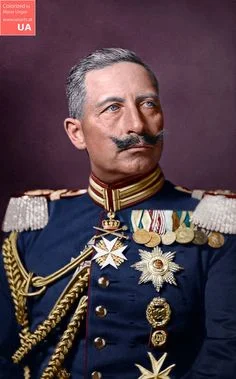 Emperor Kaiser Wilhelm ll gave Austria-Hungary a blank check. Which means if war was declared between Serbia and Austria Hungary then Germany would help Austria-Hungary. He promised his unconditional support to them.
Emperor Kaiser Wilhelm ll gave Austria-Hungary a blank check. Which means if war was declared between Serbia and Austria Hungary then Germany would help Austria-Hungary. He promised his unconditional support to them. -
 The assassination of the heir of Austria Hungary caused by a Serbian was a direct cause of World War 1. Austria-Hungary created an ultimatum with a ton of demands, but Serbia ended up breaking one of those demands. Austria-Hungary declared war on Serbia exactly one month after the death of Archduke Francis Ferdinand.
The assassination of the heir of Austria Hungary caused by a Serbian was a direct cause of World War 1. Austria-Hungary created an ultimatum with a ton of demands, but Serbia ended up breaking one of those demands. Austria-Hungary declared war on Serbia exactly one month after the death of Archduke Francis Ferdinand. -
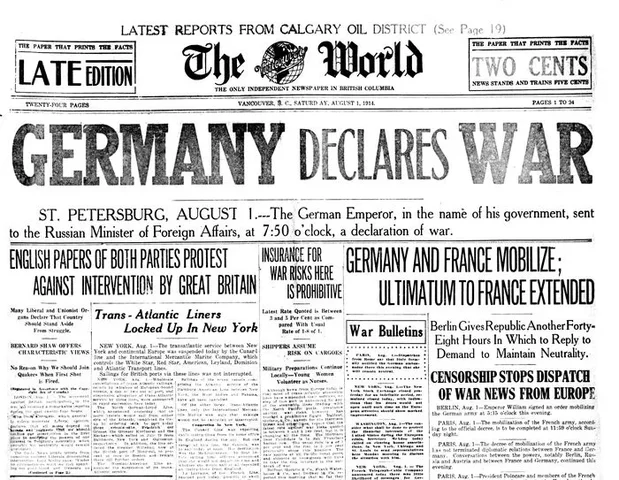 Once Austria-Hungary declared war on Serbia, Russia started to get ready for war because they were allies with Serbia. Germany told Russia to stop mobilizing for war, but Russia didn't, so Germany declared War on Russia. This war started to get bigger and more countries got involved.
Once Austria-Hungary declared war on Serbia, Russia started to get ready for war because they were allies with Serbia. Germany told Russia to stop mobilizing for war, but Russia didn't, so Germany declared War on Russia. This war started to get bigger and more countries got involved. -
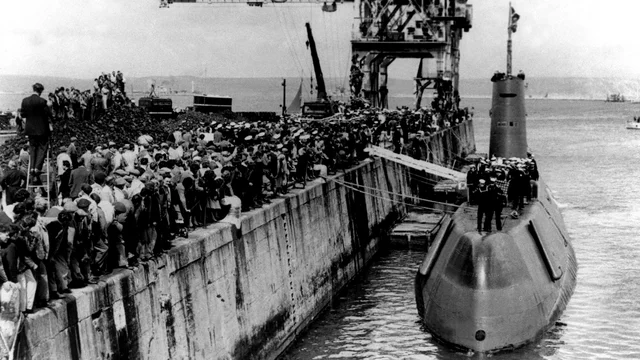 Since Russia was going to war and it was allies with France, France started to get ready for war. This caused Germany to declare war on France. The next day Germany would declare war with Britain too. More powerful countries start to enter the war.
Since Russia was going to war and it was allies with France, France started to get ready for war. This caused Germany to declare war on France. The next day Germany would declare war with Britain too. More powerful countries start to enter the war. -
 The Germans demanded to get through Belgium, so that they could reach France. Belgium at the time was neutral and the Belgium government refused them to go through. Also, Britain offered military support to Belgium.
The Germans demanded to get through Belgium, so that they could reach France. Belgium at the time was neutral and the Belgium government refused them to go through. Also, Britain offered military support to Belgium. -
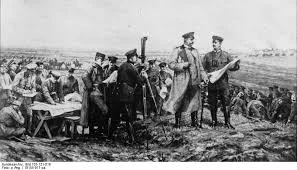 A battle fought between Germany and Russia which resulted in a German victory. The German army specifically attacked one of the Russian armies. This caused Russia to lose about half of their soldiers in that group and they had to retreat.
A battle fought between Germany and Russia which resulted in a German victory. The German army specifically attacked one of the Russian armies. This caused Russia to lose about half of their soldiers in that group and they had to retreat. -
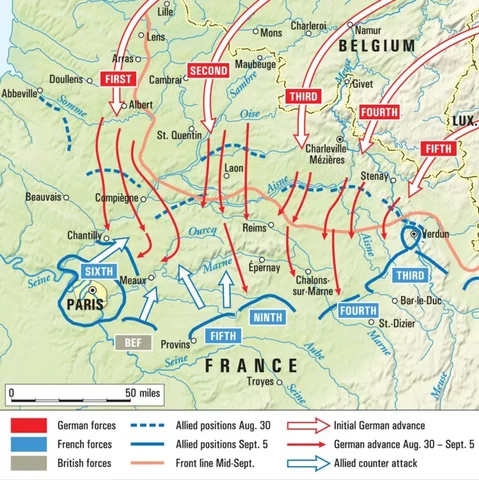 This was the first battle of World War 1 and it was fought in France. The conflict was between the French and the British on one side and Germany on the other. Germany was trying to invade Belgium, but the Allied Powers were able to mess up the Germans' plan and were able to take control of the Western Front.
This was the first battle of World War 1 and it was fought in France. The conflict was between the French and the British on one side and Germany on the other. Germany was trying to invade Belgium, but the Allied Powers were able to mess up the Germans' plan and were able to take control of the Western Front. -
 The Allies had a plan to get their ships through Dardanelles, so that they could take over Constantinople. The plan ended up back firing and they did not take down the Ottoman army like they had planned for. The battle was almost a year long and it was unsuccessful for the Allied Powers.
The Allies had a plan to get their ships through Dardanelles, so that they could take over Constantinople. The plan ended up back firing and they did not take down the Ottoman army like they had planned for. The battle was almost a year long and it was unsuccessful for the Allied Powers. -
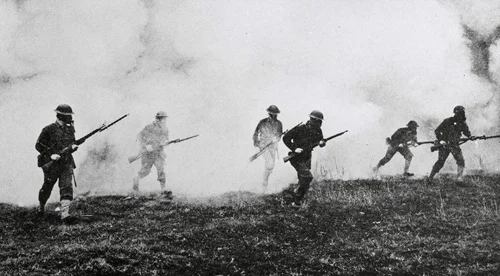 During the Battle of Second Ypres the Germans released a deadly gas on the Allie line. This caused major chaos because nobody had ever since this weapon used before. Industrialization changed the war because of all of the technology advances.
During the Battle of Second Ypres the Germans released a deadly gas on the Allie line. This caused major chaos because nobody had ever since this weapon used before. Industrialization changed the war because of all of the technology advances. -
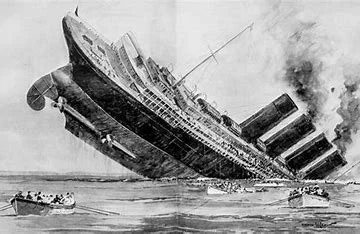 Lusitania was the name of a British ship that was sunk by a German U-boat. There were about 128 American passengers on the boat. The event brought up the idea of the United States declaring war, but they stayed neutral.
Lusitania was the name of a British ship that was sunk by a German U-boat. There were about 128 American passengers on the boat. The event brought up the idea of the United States declaring war, but they stayed neutral. -
 The battle was between the Germans and French at the hills north of Verdun-sur-Meuse in France. It was one of the most brutal and longest battles in World War 1. In total there were about 750,000 casualties from the battle.
The battle was between the Germans and French at the hills north of Verdun-sur-Meuse in France. It was one of the most brutal and longest battles in World War 1. In total there were about 750,000 casualties from the battle. -
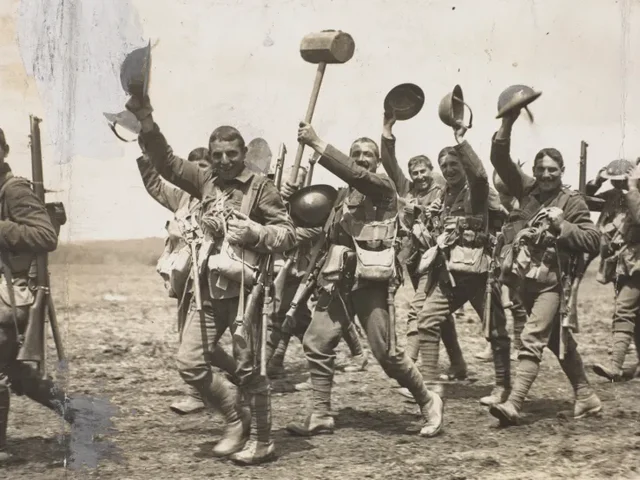 The battle started at the beginning of July and ended on November 18, 1916. The war was between the Allies and Germany.The Allies wanted to take pressure off of the French Army in the south of Verdun. It is a very well known battle because there were so many injuries and deaths. The Allies ended up taking the victory and the Germans retreated.
The battle started at the beginning of July and ended on November 18, 1916. The war was between the Allies and Germany.The Allies wanted to take pressure off of the French Army in the south of Verdun. It is a very well known battle because there were so many injuries and deaths. The Allies ended up taking the victory and the Germans retreated. -
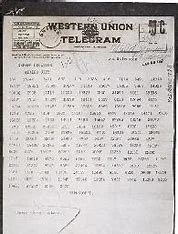 It was a coded telegram that The United States was able to decipher. Germany sent a letter to Mexico asking them to join the Central Powers. The letter concerned The United States because then they would have an enemy close by them.
It was a coded telegram that The United States was able to decipher. Germany sent a letter to Mexico asking them to join the Central Powers. The letter concerned The United States because then they would have an enemy close by them. -
 The United States president Woodrow Wilson got congress to declare war on Germany. The sinking of Lusitania and the Zimmerman note influenced this decision. Along with wanted to help out the United States' allies, Britain and France.
The United States president Woodrow Wilson got congress to declare war on Germany. The sinking of Lusitania and the Zimmerman note influenced this decision. Along with wanted to help out the United States' allies, Britain and France. -
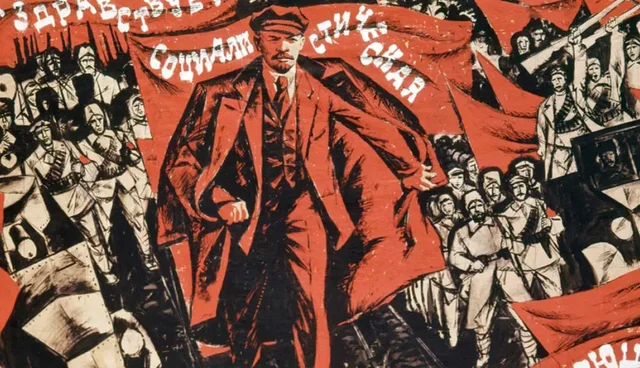 This war was between the Red Army and Anti-Bolshevik armies. The Red Army was made up of the Bolsheviks and the leaders were Leon Trosky and Vladimar Lenin. They were nationalists who fought and won the war in Russia. While WWl was still going on.
This war was between the Red Army and Anti-Bolshevik armies. The Red Army was made up of the Bolsheviks and the leaders were Leon Trosky and Vladimar Lenin. They were nationalists who fought and won the war in Russia. While WWl was still going on. -
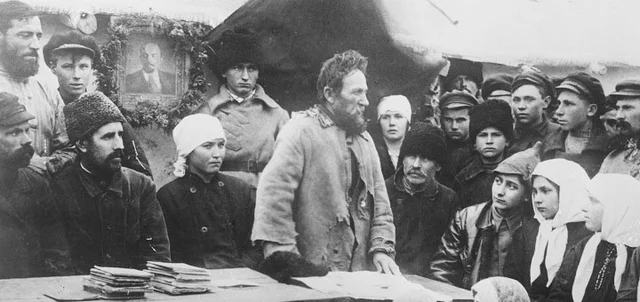 After everything that was going on in Russia with the Russian Civil War, the Bolsheviks ended up taking control. They decided it was the best for the country to withdraw from the war. Russia ended up signing the Treaty of Brest-Litovsk with Germany.
After everything that was going on in Russia with the Russian Civil War, the Bolsheviks ended up taking control. They decided it was the best for the country to withdraw from the war. Russia ended up signing the Treaty of Brest-Litovsk with Germany. -
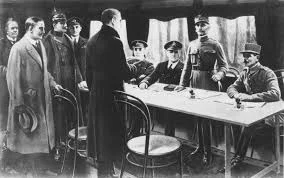 The Allied Powers and Germany agreed to sign an armistice at 11:00 am on the 11th of November. This official stopped all of the fighting in the war. Many people were still fighting up to the very second or even after 11. There were about 10,900 casualties on the final day of WW1.
The Allied Powers and Germany agreed to sign an armistice at 11:00 am on the 11th of November. This official stopped all of the fighting in the war. Many people were still fighting up to the very second or even after 11. There were about 10,900 casualties on the final day of WW1. -
 This was the official document that ended World War 1 and was signed at the Palace of Versailles. It was created and discussed between the United States, France, and Britain. The Central Powers had no say in the treaty. There were harsh punishments against Germany.
This was the official document that ended World War 1 and was signed at the Palace of Versailles. It was created and discussed between the United States, France, and Britain. The Central Powers had no say in the treaty. There were harsh punishments against Germany. -
 The main goal of the League of Nations was to prevent another big outburst or war like World War 1. The members of the group were France, Britain, Italy, and Japan. The United States was not involved with this organization. The League of Nations ended up not working because years later there would be World War 2.
The main goal of the League of Nations was to prevent another big outburst or war like World War 1. The members of the group were France, Britain, Italy, and Japan. The United States was not involved with this organization. The League of Nations ended up not working because years later there would be World War 2.
